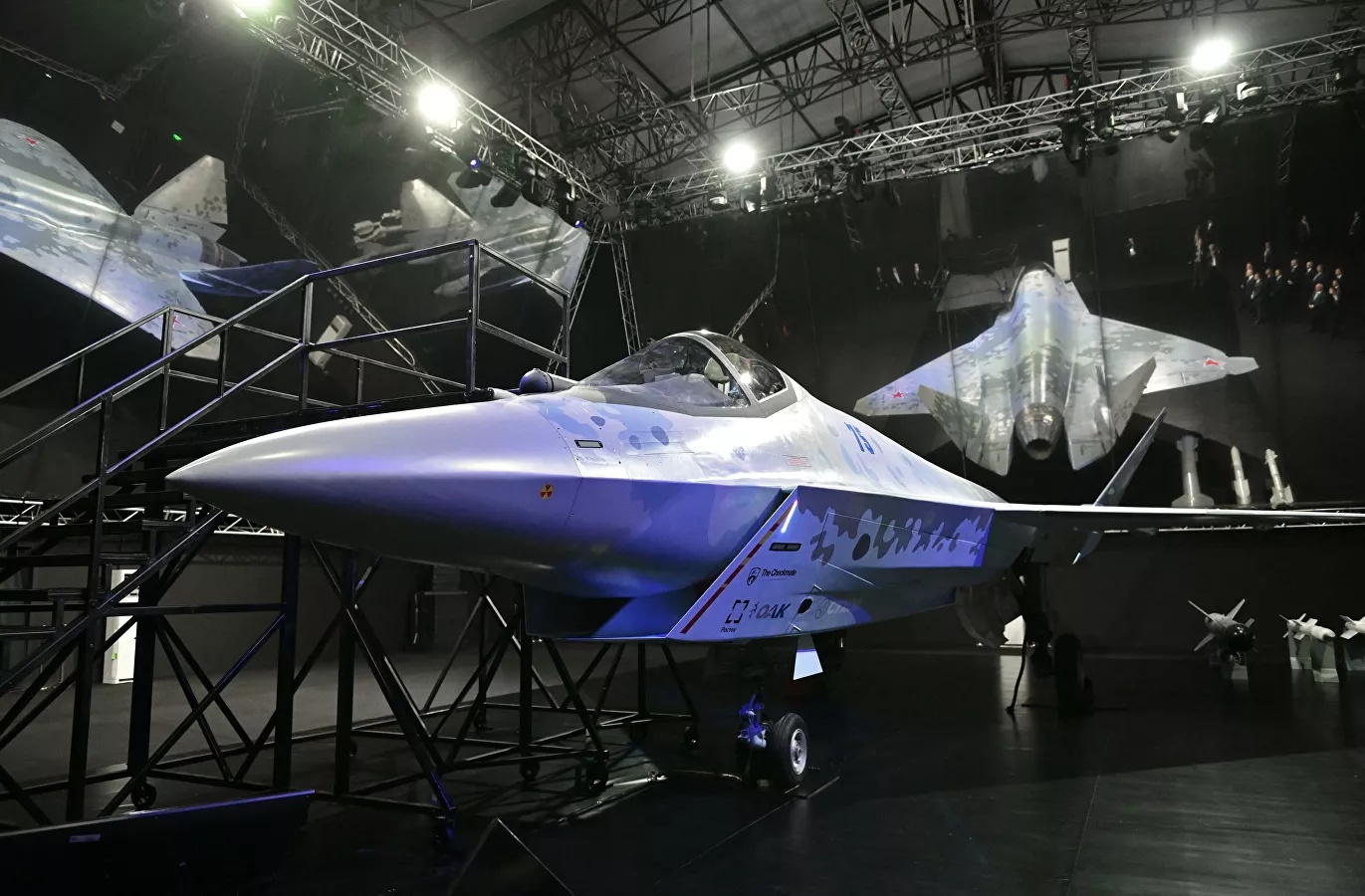Today, on the first day of the International Aviation and Space Show MAKS-2021, the new Sukhoi fighter, a fifth-generation single-engine single-seater nicknamed Checkmate was presented to the public.
The expectations were high for the new fighter jet, after several photo and video leaks in the previous days which showed a novel aircraft and in a way, a product bound to compete in the same league as the Lockheed Martin F-35.
In the morning the Checkmate was presented to the President of the Russian Federation, Vladimir Putin, and hours later the presentation ceremony for journalists took place. The premiere was global and streamed live via YouTube.
[youtube https://www.youtube.com/watch?v=PNDrTSDmaZY&w=853&h=480]The Sukhoi Checkmate
As explained during the presentation, Checkmate is a project for a new generation multi-role light combat aircraft, which incorporates advanced technical solutions but adapted from technologies already developed for aircraft such as the Su-57 Felon or the MiG-35 Fulcrum.

It also incorporates operational lessons learned from Russian force deployments in Syria and other recent conflict areas. Designed and digitally tested through the use of supercomputers, the Checkmate is designed to be effective and with a contained purchase and operation cost.
Thanks to its open software architecture, the aircraft has great potential for modernization and would allow future customers to integrate different types of electronic equipment and weapons (perhaps even foreign ones) according to their operational needs and available budget.
The new fighter will be capable of combat deployments in advanced areas, in poorly prepared airfields, under any weather conditions. To facilitate these tasks, the aircraft is equipped with an auxiliary power unit, which reduces the requirement of having equipment on the ground to turn on the electrical systems, before the main engine is put into operation.

Designed to be easy to maintain, it requires few technical personnel or specialized ground equipment to prepare the Checkmate for a mission while maintaining high operational availability, even in high-intensity scenarios.
It will have an advanced computerized failure prediction and logistics management system, which will lower the life cycle costs of each fighter. It was also stated that the Checkmate will have low fuel consumption, being of lightweight construction, with a refined aerodynamic design, and being equipped with the future Su-57 final engine, the Izdeliye 30, more powerful and economical than the current Russian generation of aviation engines.
The new fighter incorporates artificial intelligence (AI), which permanently runs diagnostics of the aircraft and informs the pilot of the condition of the systems, even giving the OK for takeoff.

Checkmate’s advantages
Thanks to its excellent thrust-to-weight ratio (close to or better than 1:1), its aerodynamics, and the vector thrust of its nozzle, the Checkmate can take off and land in short distances, can perform 8G maneuvers, and can develop excellent acceleration performances.

Its maximum speed is set at 1.8 Mach, and during the presentation it was reported that the fighter is capable of maintaining a continuous supersonic flight regime, perhaps a different way of saying that it has the ability to «supercruise», that is, to be able to fly at more than Mach 1 without the use of afterburner.
Its clean range (without extra fuel tanks) is advertised in the order of 2,800 km. Its combat radius, depending on the configuration, could be in the order of 1,000 to 1,500 km.
Payload and weapons
Its maximum combat load is 7,400 kg. A good part of it can be located inside the internal weapon bays, of which the Checkmate has 3, two of them lateral and one under the fuselage.

Short-range air-to-air missiles of the Vympel R-73/74 family or future developments can be housed in the side pylons. In the central bay, inherited from the one developed for the Su-57 Felon, 3 of the new Vympel R-77M medium / long-range air-to-air missiles can be accommodated for air-to-air missions.

In air-to-surface functions, the point under the fuselage can house bulky weapons such as the Kh-59Mk2 cruise missile, modular Grom-type guided bombs (or missile, in its engined version) or the Kh-58UShKE long-range anti-radar missile.

In short, on pylons externally or internally, Checkmate can carry almost all the weapons in the Russian arsenal, even the new generation ones developed to be housed in the internal bays of the Sukhoi Su-57 Felon.
Finally, the fighter has a cannon, possibly the same as the 30mm Su-57, located in a pod that is housed within one of the lateral bays.

Sensors and data management
The new combat aircraft incorporates various advanced active, passive and cooperative detection systems, whose data is analyzed and combined by artificial intelligence, which acts as a co-pilot, to offer detailed situational awareness to the pilot.
It has an AESA radar, possibly derived from the one present in the MiG-35 or Su-57, with great resistance to interference and is capable of attacking 6 targets simultaneously.

It also has a passive infrared detection and tracking system in the front in the upper section in front of the cockpit and a new (for the Russian industry) optronic system type EOPS under the fuselage, just behind the front landing gear, similar to the one used by the F-35 and J-20, for the detection and monitoring of air and ground targets, which should also offer the possibility of laser illumination for the use of guided weapons.
It also has an optronic hemispherical detection system, like that of the Su-57, for 360° detection of enemy aircraft and missiles.
These elements are complemented by an advanced passive electronic detection system, which makes it possible to identify and locate enemy radar emissions, whether from fighters, missiles, AWACS-type aircraft, or air defense radars.

The information collected by all these sensors is presented, in an orderly and coherent way, on a large front screen, like that of the Su-57 and MiG-35, in addition to the HUD and the pilot’s helmet with integrated sight.
Defensive systems
Logically, the main element of defense of the Checkmate is its stealth capability to avoid radar detection. But in situations where this is not enough, the aircraft has an advanced integrated electronic warfare system, as well as other classic means of defense such as chaff and flares to deflect enemy missiles.

The Su-57 incorporates an active defense element, using 2 laser illuminators, to confuse and deflect approaching infrared missiles. The Checkmate could make use of this system as well should it be required by the operator.
Unmanned
Checkmate will also be developed as an unmanned combat aircraft, which will be able to accompany and provide protection to other manned fighters, working as a team through a multi-band data link, with high resistance to interference.
It will allow the information obtained by each aircraft to be shared with all the members of the attack group. It should also allow the Checkmate pilot to receive information, control and manage other unmanned means present in the area of operation.

The aircraft presented is an initial prototype. A more finished version is expected to have its first flight in 2023. Other prototypes will follow between 2024 and 2025. The first production units could begin to be delivered in 2026.
Depending on obtaining adequate funding and if development proceeds smoothly, these optimistic dates could be met. Keep in mind that most of its construction systems and techniques have already been researched for the Su-57, thus saving on costs and implementation time.

The new Sukhoi Checkmate is presented as an advanced capability yet affordable fighter for the retrofitting of air forces with a modern fifth-generation weapons system, and an alternative for nations that for budgetary or political reasons cannot acquire the F-35 Lightning II.






